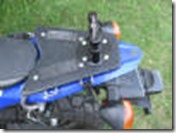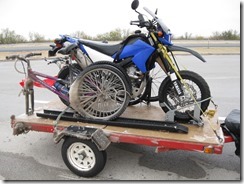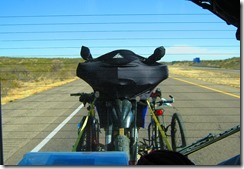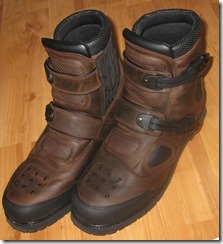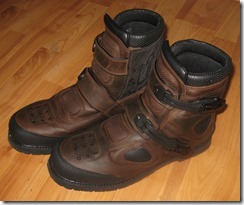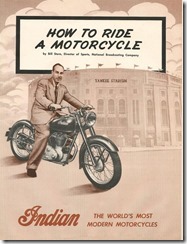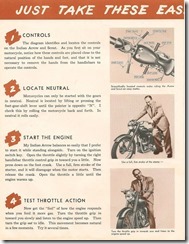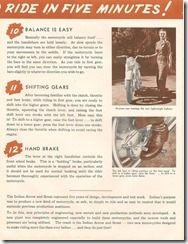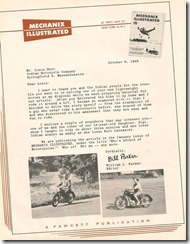This is why I don’t like biker parades, too much stupid in one place never comes to a happy ending.
All Rights Reserved © "Never argue with a fool; onlookers may not be able to tell the difference."
- Mark Twain I check the comments on this blog regularly. The idea is that we're going to have a conversation about the ideas I've presented. You should be aware of the fact that when someone emails me an interesting comment, the odds are good that I'll post that in the comments anonymously and reply to that comment on the blog rather than in email.
Jun 30, 2015
Jun 29, 2015
#115 All or Nothin'
 |
I wonder if the "all or nothin'" attitude is an American foilble? There is no shortage of intolerant religions around the world, so I suspect we're just the devils I know rather than some original-thinking exception. This came to mind when I read my daughter's latest short biography; "A History of the Small Press" This is exactly the kind of book that would drive any Midwestern guilt-ridden parent to a hermitage. Although parenting ought to have been more than enough stimulation to get that job done.
Holly tells a teenage-angst-filled tale of how the world didn't get her and drove her to failure in high school and the radical edge of rich-and-middle-class-kid punk rock society in the tough, unforgiving world of southern California teenage drama. As Martin Mull told it in Ukulele Blues, "I woke up this afternoon . . . I felt so lowdown . . . I threw my drink across the lawn." From her perspective, she had no choice but to rebel against the oppressive "structure" provided by her hippy parents. This is exactly the kind of tyranny that spawned the American Revolution or, at least, inspires grade school children to complain that their chocolate milk was made with 2% instead of whole milk.
From my perspective, it was pretty obvious that a kid who had always been the "smartest kid" in her small Midwestern schools was overwhelmed in a 3,000 student California high school taking AP classes with 30 other "smartest kids." Rather than kick up her game, she quit playing and hung out with the dumb kids so she could feel smart without having to work for it. My wife and I tried a thousand ways to explain to her how foolish that tactic was, but while, physically, teenagers are adults, they have been mentally retarded by raging hormones and are usually less susceptible to rational argument than they were as infants. Today, Holly is on the parent side of this experience and is just as confused as my wife and I were 25 years ago.
I see that same attitude in a lot with newbie motorcyclists; and folks who ride like beginners and appear to be proud of it. Motorcycling requires the development of a lot of skills and practicing those skills often result in the rider's looking pretty foolish. Most people spend more time pretending they look cool than doing the things that actually are cool.
People buy motorcycles they can "flat foot" because they're afraid they won't be able to make a smooth stop, or start, if they can't paddle their way up to speed. For rank beginners (with less than a few hours on the saddle) there might be something to this, but anyone who rides well learns how to change velocity without using his feet as training wheels. Bicyclists learn how to deal with not being able to touch the ground from the seat pretty early on, but not all motorcyclists are competent bicyclists. Some have never ridden a bicycle, hard as that is to believe. Even more to the point, there is nothing about paddling from start to stop that looks cool to anyone but the same characters who think pirate outfits and gangster tats are hip. The rest of us just shake our heads and do whatever we can to disassociate ourselves from what the public calls "bikers."
Developing any physical skill requires only one thing; practice. Hours and hours of practice; 10,000 hours, if you want to get really good. Few of us want to put in that kind of time doing something difficult. A lot of us don't ever "practice" mastering anything. Learning how to practice is one of the necessary skills every "expert" has to acquire (except economic experts who just make up crap and call it "science" and "facts" and laugh at the rest of us when we believe them). I've been playing guitar since I was 13, but I'm still a beginner because I quit practicing once I played well enough to reproduce pop songs. Doing what you know is not practice. Doing what you suck at is practice.
I rode and raced motorcycles for forty years before I seriously began to practice riding technique. Other than working at trail riding and off-road racing techniques, after three decades of riding I had not much more real practice under my belt than I had after a few weeks of riding my brother's Harley Sprint to work. Including those hours of off-road work and what I've learned since becoming an MSF instructor, I suspect I have about 3,000 hours of actual riding practice. At this rate I won't live long enough to become half of an expert. Just being in the saddle isn't practice. I probably have logged 8,000-20,000 riding hours (depending on how you time approximately at least 350,000 miles of motorcycling). Little of that riding time lives up to the higher standard of practice.
Because motorcycling is a life-support activity, getting good at it is an all-or-nothing affair. When your skills are called for, you either have them or don't. If you don't, you may not get a second chance to decide what kind of motorcyclist you're going to be.
When I admonish other riders to practice life-saving skills, it's another case of the kettle calling the pot "black." I also need to keep practicing those skills because they are the difference between me riding jelly-side-up or skidding down the road jelly-side-down.
MMM March 2013
Jun 26, 2015
Book Review: Down and Out in Patagonia, Kamchatka, and Timbuktu
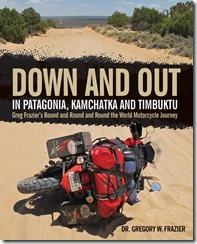 by Dr. Gregory W. Frazier, 2014
by Dr. Gregory W. Frazier, 2014
All Rights Reserved © 2014 Thomas W. Day
While I've met, talked to, and even sat on a discussion panel with Dr. Frazier, Down and Out introduced me to more things about him and his past and his motorcycling adventures than I knew was available to learn. For one, who knew that Dr. Frazier was a Texas hippie? Not me. If I had, we'd have had completely different post-VBR-session beer drinking events. For two, Dr. Frazier's experiences with Harleys and Indians was a complete surprise to me.
A segment of the Motobooks press release has this to say about Dr. Frazier and his motorcycle history, "The first-ever, first-hand chronicle of Dr. Gregory W. Frazier's never-ending motorcycle ride. A little over 40 years ago, a man named Gregory W. Frazier got on his motorcycle, went for a ride, and never returned. He's still out there, circumnavigating the globe: exploring the jungles of Asia in the winter, trout fishing in Alaska in the summer, and covering all points in between during the rest of the year. He's been shot at by rebels, jailed b y unfriendly authorities, bitten by snakes, run over by Pamplona bulls, and smitten by a product of Adam's rib. He's circled the globe five times and has covered well over one million miles (and counting). During those past four decades, Dr. Frazier has been chronicling and photographing his around-the-world adventures, publishing 13 books on the subject (including one previous title with Motorbooks), the majority of which have been manuals for touring specific locations or general how-to-tour-by-motorcycle books. He has also produced 9 documentary DVDs, but until now, nothing in print has encompassed the entirety of his worldwide motorcycle adventures. . ."
I don't think any readable book could hope to have "encompassed the entirety of his worldwide motorcycle adventures," but this book does a pretty good job of explaining who Dr. Frazier is and where he's been. For $35 list ($26.15 on Amazon.com and $26.25 on Motobooks.com) you can read about Dr. Frazier's early exile from his family due to his motorcycle fixation and mediocre study habits (I never did figure out where the "Dr." comes from.) all the way to his inventive methods of financing his around-the-world adventures and his trip around the world with a handicapped passenger. In between, are his adventures, his motorcycle "education," and a lot more about the man than I've gleaned from his previous books. Fraizer is a complicated combination of humble aware-of-his-Ugly-Americanism tourist and a confident, in-crowd world traveler. He's hard not to like.
In 2010, Frazier retired from round-the-world travelling, which does not mean the same thing for him as it does for mortals, "I’m not done tasting the environments, economies and cultures of the world from atop a motorcycle. There are still plans to attempt reach distance places, as well as to return to some I want to see more of, like Colombia and Brazil in South America, as well as more of Eastern Asia and Africa. I merely plan to quit this foolish squandering of travel funds to transport motorcycles over water. 75% of the earth is water and the increasing costs and bureaucratic hassles associated with transporting motorcycles to the remaining 25% have been seriously cutting into my remaining travel years and project budgets."
Down and Out provides a lot details about the cost and complication of those "projects," but it would require a whole book to fill in the blanks if you are hoping that reading this book will put you in a position to fill Fraizer's shoes. As he says, more than once, he was fortunate to have been bitten by the travel bug at a rare moment when politics, economics, accessibility, and temperament all aligned to allow him to go the places he went relatively safely and inexpensively. Many of those places are unstable and insanely violent today. Even more of those places are specially hostile to Americans (although Fraizer often identified himself as a "Canadian"). So, reading Down and Out has an aspect of a time piece and a history book. Still, brave people are riding motorcycles in remote and hostile places every day and Dr. Gregory Fraizer has been an inspiration to many world travelers. This book will be one more stone in the staircase he has built to put us all on the roads around the world.
Jun 23, 2015
Reliability, We Don’t Need No Stinkin’ Reliability
Consumer Reports, that biker-oriented magazine, recently published an article titled “Who Makes the Most Reliable Motorcycle?” Not surprisingly, Yamaha, Suzuki, Honda, and Kawasaki topped the list with 11-17% 4-year failure rates. Equally no surprise, except to their dedicated fanbase, Can-Am, BMW, Ducati, and Triumph were at the bottom of the list with 29-42% failure rates. The whole detailed customer satisfaction report is pretty interesting.
Three wheel vehicles, especially two-in-front-one-in-back styles, are particularly trouble-prone. “Cruisers appear to require fewer repairs than other types of motorcycles, with just a 15 percent failure rate by the fourth year of ownership.” If my Craig’s List spreadsheet is any indicator of what that might be, I’d suspect the incredibly low mileage is a big part of why cruisers don’t fail much. They also aren’t ridden much.
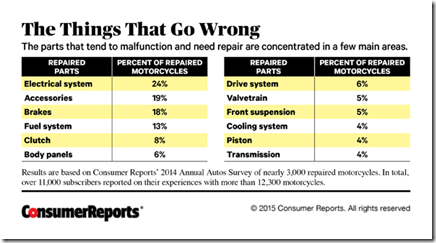 The cost of maintenance is pretty interesting, too. “Of those that did incur out-of-pocket expenses, the average motorcycle repair bill was $342, with the cost being heavily dependent on brand and type. For those brands that we have adequate data on, median repair costs ranged from $269 for Kawasaki to $455 for BMW. Dual-sport/adventure bikes and cruisers were less expensive to repair, costing $313 and $322 on average, and sport touring models were pricier at $383.” The stuff that breaks is equally interesting, with electrical systems at 24%. So much for how installing more electronics in our bikes and cars is going to make them more reliable. Personally, I’d be the cheap and mis-applied connectors are a huge contributor to this failure mechanism.
The cost of maintenance is pretty interesting, too. “Of those that did incur out-of-pocket expenses, the average motorcycle repair bill was $342, with the cost being heavily dependent on brand and type. For those brands that we have adequate data on, median repair costs ranged from $269 for Kawasaki to $455 for BMW. Dual-sport/adventure bikes and cruisers were less expensive to repair, costing $313 and $322 on average, and sport touring models were pricier at $383.” The stuff that breaks is equally interesting, with electrical systems at 24%. So much for how installing more electronics in our bikes and cars is going to make them more reliable. Personally, I’d be the cheap and mis-applied connectors are a huge contributor to this failure mechanism.
Don’t Believe Me, Read This
[Thanks Paul]
Carmakers need to fear for their lives—and it’s not just about getting electric cars right
“When you put the two together, you get urban-dwellers tooling around in shared, autonomous vehicles, and—reckons Bill Ford, executive chairman of Ford Motor—buying far fewer cars. Ford has said the company is already having to adapt because of shared driving, and predicts that autonomous functions just short of self-driving will be installed in most vehicles within five years.”
Go for the comments, too. There is a chimp named “Topper Gunns” who appears to not only be illiterate but universally clueless. Comments sections are, apparently, where the mentally naked can go to expose themselves.
Jun 22, 2015
#114 Something Happened Here
 |
Minnesota's most famous citizen once wrote, "Something is happening here, but you don't know what it is. Do you, Mr. Jones?" After a few years of talking about why motorcycles don't get decent fuel economy, Honda went behind my back and did something about it. I didn't even notice, until a friend bought an NC700X and wrote, "Got over 2,000 miles on the bike. Last 3 fill-ups I got 77, 79, and 92mpg." Even though Honda had advertised the bike's economy at 64mpg, a lot of new owners have been surprised with significantly better mileage over a wide variety of conditions. I hope this series of new-breed-motorcycles aimed at motorcyclists in the 21st Century has the success it deserves. For decades, we've been served motorcycles that concentrate on performance and, mostly, ignore fuel economy. Even small bikes, like my Yamaha WR250X, barely improve on the 35-45mpg standard motorcycle efficiency expectation. A few years back, I did a review of Motorcycle Consumer News's bike spec wrap-up and found that fuel economy was actually declining as fuel prices increased. The best mileage bikes in their spreadsheet were mediocre performers relative to economy cars.
Reality-deniers aside, fuel is only going to become more expensive. We are on the downside slope of frantically scratching out the last bits of fossil fuel for increasingly irrational costs and vanishing energy efficiency. Oil companies are making another round of the near-empty wells throughout the Midwest, siphoning the last drops with pumps that haven't been powered up since the 70's. We're drilling two miles down and two miles across to tap into the Bakken formation's barely-accessible reserves for negative energy returns to encourage the illusion that the country is "energy independent." Economically, other industrialized nations are leading the move away from inefficiency and obsolete technologies while we pretend that shuffling over-hyped paper is actual work. With all that in mind, someday soon a liter sportbike that barely manages 20mpg will be about as Craig's-List-able as an electric typewriter or a sewing machine.
The two efficiency problems with motorcycle design are (1) the fact that "you can have power or you can have economy" and (2) motorcycle aerodynamics are, as Kevin Cameron described, "ugly . . . [compared to] cars, which can have very much better drag coefficients even though their frontal areas are greater." In the past, the majority of motorcycle engine designs have been about power and appearance, mostly neglecting economy.
With the NC-series (New Concept), Honda only sort of goes after aerodynamics with the stock fairing design, plus accessories like a taller windshield and upper and lower cowl deflectors. That's not going to return many efficiency returns because the human body is about as aerodynamic as a flag. Unless we're willing to can ourselves into bullet-shaped containers, aerodynamic improvements may be minimal.
So, Honda attacked the problem from the engine design direction. As one reviewer put it, "This has the potential to be the most significant motorcycle engine of recent times." The most simple explanation of the NC's motor is that Honda designers halved the four-cylinder motor used in the Jazz and the Fit and stuffed it into a motorcycle frame. It's more complicated than that, but only because the sawed-in-half motor wouldn't hold fluids. Otherwise, there are more similarities between the two vehicle power plants than differences. The NC's engine bore and stroke (73 x 80mm) are the same as the Jazz car engine; as are many of the engine components and the 6,500 rpm redline and 3,000 rpm shift-points and torque curve. A single throttle body feeds both cylinders in a 270-degree crank configuration. The pistons are coated with a low-resistance resin and the rockers are on roller bearings to reduce friction. There is a single counter-balancer to reduce weight and friction. This engine was designed, primarily, for fuel efficiency while hanging on to the fun-factor, secondarily.
While developing the NC-concept, Honda did something weird; the company's engineers studied what motorcyclists do with their motorcycles. Honda's research determined that riders spend 90% of their riding time well below 85mph and designed the NC accordingly. Honda claims the bike gets to 75mph faster than the CBR600, with the theory being that everyday riding won't feel inhibited by the high efficiency design. The motor produces 51hp, which isn't chicken feed by cruiser standards but the design's intent is to provide cage-like performance while retaining the fun of two wheels.
The rethinking didn't stop with engine design, either. The NC's frame is described as "the platform," car jargon, because the concept's platform had to be suitable for three significantly different vehicles (the NC700X/NC700S/Integra scooter, the last two models are not exported for the USA markets). The area between the seat and the handlebars no longer contains fuel, but has become a very useful storage area sized to hold a full face helmet. The fuel tank is under the seat, lowering the bike's center of gravity and improving the low speed stability and handling.
Based on review comments, I suspect it will take a few generations of this kind of bike before the hooligans who make up the majority of bike reviewers get it. Practically every new idea in motorcycling has met with derision from the press and this one won't be any different. With that in mind, I suggest that, if this approach appeals to you, you read as little as possible about the bike and go ride one.
For the last several years, I've expected motorcycling to slowly vanish into the buggy-whip territory of obsolete-toys-that-rich-guys-still-play-with. Smart roads don't include motorcycles in their design parameters. If the NC makes a dent in the market, Honda may have put some future into motorcycling's future.
MMM Winter 2012
Jun 20, 2015
Product Review: More Miles for Me
All Rights Reserved © 2012 Thomas W. Day
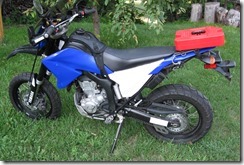 After my 2011 cruise around Lake Superior, my only bitch about the WR250X is the mediocre mileage. At 55mpg, the stock two gallon tank barely gets me past the 100 mile mark before the fuel injection is sucking fumes. Yamaha claims 71mpg for this bike, but I have never done better than 62 and the Lake Superior trip knocked down 55mpg for several tanks in all sorts of conditions. I installed a 3.1 gallon IMS tank, which gives me closer to 170 miles between full to drained, but 150 to reserve is pretty predictable. I need a minimum of 200 miles per tank for touring. What to do?
After my 2011 cruise around Lake Superior, my only bitch about the WR250X is the mediocre mileage. At 55mpg, the stock two gallon tank barely gets me past the 100 mile mark before the fuel injection is sucking fumes. Yamaha claims 71mpg for this bike, but I have never done better than 62 and the Lake Superior trip knocked down 55mpg for several tanks in all sorts of conditions. I installed a 3.1 gallon IMS tank, which gives me closer to 170 miles between full to drained, but 150 to reserve is pretty predictable. I need a minimum of 200 miles per tank for touring. What to do?
I looked at the IMS 4.5 gallon tank, but sticking 27 pounds, plus the tank weight that far forward on a lightweight 250 seems like a bad idea. I like the front suspension somewhat soft and that won't work if I load up the front tire with more fuel weight. Plus, I do not trust the idea of making the radiator guards into fuel storage. I've read about a few guys who have crashed off-road and gouged a hole in one of those protruding scoops, losing all of their fuel capacity. I like my "guards" to be guards.

 At first, I thought about mounting the bracket on my Yamaha rear rack, but that would screw up the rack for every day use. Target sells a 9-1/2 x 15 x 1/4" black polyethylene cutting board that sells for about $10. Poly cuts easily on a table saw with a plywood or crosscut blade, so I hacked out a plate that fits on the my rear rack's frame. A little finish work, $3 worth of stainless screws and washers, and I have a solid mount for the gas can and it is narrow enough for my Giant Loop Coyote Saddlebag to fit over the tank and attach normally. Even better, with a $20 extension, I can load up two 1 gallon tanks, still use my Giant Loop gear, and get a 250 mile or better range out of the WR. Now, we're talking adventure touring!
At first, I thought about mounting the bracket on my Yamaha rear rack, but that would screw up the rack for every day use. Target sells a 9-1/2 x 15 x 1/4" black polyethylene cutting board that sells for about $10. Poly cuts easily on a table saw with a plywood or crosscut blade, so I hacked out a plate that fits on the my rear rack's frame. A little finish work, $3 worth of stainless screws and washers, and I have a solid mount for the gas can and it is narrow enough for my Giant Loop Coyote Saddlebag to fit over the tank and attach normally. Even better, with a $20 extension, I can load up two 1 gallon tanks, still use my Giant Loop gear, and get a 250 mile or better range out of the WR. Now, we're talking adventure touring!
Jun 18, 2015
I Am Prejudiced
Jun 17, 2015
Product Review: Geza Gear Elite-Plus Half-Cover
All Rights Reserved © 2014 Thomas W. Day
Pre-Geza Gear, the bicycles, the WR250X, the trailer, and everything attached was covered in slush and ice after 350 miles of miserable west Texas weather.
Not much went well for the first couple of months on our 2013-2014 attempt to play snowbirds. A day before we left home, my custom-fitted Harbor Freight trailer took a hit when a friend decided to stand on the hitch to counterbalance loading the bike and bent the frame so badly I almost decided to leave the bike at home. The VW-based RV turned out to be allergic to rain, ice, and snow. Our planned route was sacrificed to accommodate the perfect storm of failing vehicle, unseasonably cold and wet weather in practically every direction, and even our bicycles turned out to be more of a hassle than assets.
The only thing that worked as expected was my beautiful and beloved Yamaha WR250X. After 350 miles of slogging through a sudden ice storm between central Texas and Carlsbad, New Mexico, I expected to have done permanent damage to that sorely abused machine. After I slid it off of the trailer and cleaned it up, the best sound I could have imagined was when the little bike fired up instantly in 30F weather and got me into Carlsbad for much needed groceries and supplies. I immediately went on-line to find a cover that would protect my blue beauty from any more vicious weather. I found Geza Gear (www.gezagear.com) and that company's assortment of stretchy covers that are guaranteed to survive practically anything from 12 to 72 months, depending on the model.
All loaded up and ready to go exploring; sleet, snow, or rain be damned.
On the advice of Geza Gear's customer service, I went for the fairly expensive Pro-Elite version of the cover, along with the stuff sack and mirror covers for about $270 shipped. The cover arrived just in time to go through the last round of ice and wind before we left Albuquerque. Since then, the bike has been protected by that cover for 3,800 miles of, mostly, bright sun and heavy winds traveling around New Mexico and back home through Texas, Oklahoma, Missouri, and Iowa. We did hit a little blast of rain in Missouri, but it didn't test the cover much.
The Pro Elite's #9238 material is a wonder. You can cut slits in the stuff for tie-down straps to pass through without worrying about those incursions turning into never-ending tears. The stuff is tough as leather and flexible as Spandex. Not once in all of those miles the cover even appear to make the slightest effort to blow off; and we took some buffeting from near-tornado winds in Texas and a Dust Bowl-quality storm in Roswell, New Mexico.
All of their materials are designed to "materials can take the punishing effects and monumental stresses of applied wind-forces from 55mph to over 100mph while being towed on your motorcycle on an open trailer cross-country, without shredding or buffetting." The custom designed materials are not off-the-shelf stuff you can find from any other manufacturer that I know of. With names like Elonitec, Elonitec/Antron, Duracor, Iridiex, #9238, #12373, LX88, and Iridiex/Kevlar/GoreTex, I'm not sure where you'd start to look, if you wanted to imitate Geza Gear's product line.
The rear view window look at the cover on the road at 65mph. Barely a flicker from the material and all of the important bits are protected.
There isn't much that I can add to the company's claim that their covers are "cut and sewn is determined from YOUR EXACT bike year, make and model." The Yamaha WR250X isn't exactly a common animal and it's a long ways from the kind of motorcycle on which Geza Gear's products are probably found, but they assembled a cover that was an exact fit for my motorcycle, including some cute rearview mirror covers and cutouts for the mirrors and a lift for my bike's short windshield. You can see from the included pictures how precisely the cover fits my bike and how little motion there is in transit. For someone who is going to be travelling for a while, I have found nothing comparable.
There are a lot of decisions I made that winter that I would avoid on a second pass, buying my Geeza Gear cover is not one of them. I expect to get years of service out of this terrific protection.
Jun 15, 2015
#113 Coffee and Motorcycles
 |
The two go together like politics and corruption, right? You can't ride a motorcycle for any serious distance without the assistance of the coffee bean. More importantly, I don't.
I was slow to my coffee addiction. Until I was in my late 30's, I hadn't messed with coffee (or any other stimulant) and couldn't see a reason for doing so. My argument was "I might need my adrenal gland for something real someday, like running from rabid dogs. I want adrenaline to work when I need it." Robin Williams' statement about coke ("Anything that makes you paranoid and impotent, give me more of that.") seemed to apply to me, too. That was a good argument when I was young, active, still producing snippets of testosterone, didn't have a titanium ass, and practically jumped out of bed in the morning "ready and raring" to get on with my day.
I am no longer that jackass. Today, I desperately need a service person (preferably someone young, attractive, female, and scantily clad) to administer some kind of combination of lubricant and pain reliever to most of my joints so that I can carefully ease my busted body out of bed with minimal shock and the complete opposite of awe. Once I'm mobile and wandering around the house aimlessly, I need caffeine to provide whatever focus I'm going to have for the day. And you know that I know the difference between "need" and "want."
I know. I'm kidding myself. This is another example of doing something stupid simply because it is easy, more fun than the alternatives, quick, and effective. A real man would kick himself out of bed, do fifty pushups and one-hundred setups before going to the kitchen and downing a blended concoction of organic carrots, a banana, blueberries, a raw egg from a free-range chicken, extract of Eurycoma longifolia root, and unflavored protein supplement. Screw that, I grind up some fresh Ethiopian coffee and give my adrenal system a beating it won't forget until bedtime. If the coffee washes down a couple hundred miligrams of naproxen sodium, I can ride twenty hours alertly and relatively painlessly. Double the naproxen dose and I can crisscross Alaska in two days with a broken finger, a separated shoulder, and some cracked ribs. At least I did in 2007. I'm assuming similar capabilities today, minus five years of wear-and-tear.
I got into coffee during my last year as a full time student in 1990. I was working 50-hours-a-week as a manufacturing manager and taking 12-15 units of evening classes at UCLB. Some of my classes started at 7PM and most weekdays I made it away from the campus near midnight. That left me with about five hours a weekday for sleep, assuming I did no homework. I was driven to be on the Dean's List, to justify being so late to an undergrad degree so I did a lot of homework. At the beginning of that year, I struggled to stay awake in my later classes. A friend introduced me to the school's fine cafeteria and their excellent fresh roasted South American and African blends. I did not have the drowsiness problem again, but I often did stay up doing homework until 3AM.
All that in the past, I really fell in love with coffee in Denver in the 90's. A friend's girlfriend invited a bunch of us to Saturday morning coffee at her new shop on the edge of Cherry Creek North. When I told her I drink coffee purely for the energy hit, she poured me a big cup of an Ethiopian blend. Not only was that the best tasting coffee I've ever had, but the stuff packed a punch.
A while later, we all split, some of us heading south on Colorado Boulevard on our way to Colorado Springs and a ride up Pike's Peak. I was on a friend's Honda NT650 Hawk, a bike he never rode and one I loved at least as much as my Yamaha XTZ550 Vision. As usual, the pack was slow to leave the parking lot and I was on the road a bit ahead of them. I was enjoying the caffeine buzz and the perfect morning mountain air, when a siren fired off just to my right and a fire truck jumped into my lane not more than 100 feet in front of me; probably less. I nailed the Hawk's wonderful brakes, doing a front wheel stand-up that would have made Robbie Madddison proud. At least, I wouldn't have embarrassed him. Much.
The driver had stopped in the middle of the road, when he realized he had barreled out of the garage with no warning and was about to plow into heavy north-bound traffic. I don't think he saw me, at all, until we were eyeball-to-eyeball with the Hawk's back tire three feet in the air and my full-face helmeted head staring at him, just a little pissed off. I was no more than a dozen feet from the fire truck's driver's side door when the back wheel bounced back to the ground. I have never seen bigger eyeballs than the fireman was wearing that morning. Fortunately for both of us, I had no close traffic behind me to add to the excitement.
As soon as the Hawk's suspension settled down, I pumped my right arm and hollered, "Fuck me! Let's do that again!" I was so jazzed up, I really did want to do it all over again, to see if I could stop even closer to the fire truck. I don't remember saying anything, but the guys I'd left at the coffee shop had caught up just in time to see the Hawk touch ground and to hear me. One of my friends sent me an email, with that line as the subject, on my birthday for several years afterwards.
I learned two valuable lessons from that experience: "There is no such thing as too much caffeine" and "I love the 1988 Honda Hawk's brakes." You might think there could be more to take away from an experience like that, but . . .
Nope, that's all I got.
MMM October 2012
Jun 14, 2015
Embarrassing Myself
We’re lucky to have a great local bookstore in Red Wing, Fair Trade Books. Rick, the owner, is heavily invested in the city, culture, and the local arts scene and one aspect of that is an open mic the bookstore hosts on the first Thursday of every month. The “audience” is mostly made up of people who are waiting to perform some music, read a bit of poetry, do some piece of improv, perform magic, read a chapter of a book they’ve just written, or tell a story.
Several months ago, I conned myself into thinking this would be good motivation for me to learn some songs, practice my guitar, and force myself in front of an audience after a 30 year much-appreciated-by-everyone hiatus from that sort of thing. I worked up a favorite Dylan song and a J.J. Cale tune I’ve fumbled with for almost 35 years. It was a disaster. I couldn’t see my sheet music and completely failed to remember the lyrics after practicing these two songs for at least 50 hours. I completely and totally sucked. I have always hated playing for an audience, even when I was doing it 3-5 times a week in my musical “prime” and nothing has changed over the years. I still hate it and am scared shitless for hours before and after anything that resembles a performance. All of that would be just a bit of the reason I ended up on the tech-side-of-the-glass in recording studios and live music.
 So, I put away the guitar and having done much more than occasionally dust it since. I still have some hope that I might start playing again, just to entertain myself, but those few minutes in front of an incredibly supportive audience about drained that desire from my psyche. I played the shit out of my nasty Martin Backpacker the winter we spent lounging around Elephant Butte Lake, New Mexico and when I got home I gave that rat-bastard instrument to my granddaughter and replaced it with a terrific sounding and playing Composite Acoustics Cargo travel guitar. It would be a shame to have wasted that effort.
So, I put away the guitar and having done much more than occasionally dust it since. I still have some hope that I might start playing again, just to entertain myself, but those few minutes in front of an incredibly supportive audience about drained that desire from my psyche. I played the shit out of my nasty Martin Backpacker the winter we spent lounging around Elephant Butte Lake, New Mexico and when I got home I gave that rat-bastard instrument to my granddaughter and replaced it with a terrific sounding and playing Composite Acoustics Cargo travel guitar. It would be a shame to have wasted that effort.
However, the brilliant and generous guy who ran the open mic night for Fair Trade moved to Sweden and Rick rang up all of the past contributors for last Thursday’s event to make sure it didn’t die. I thought about fighting my stage-frightened demons and trying another song, but I didn’t have the guts. So, I printed off a handful of old Geezer columns and a pair of yet-to-be-published rants and offered to read myself as a “talent.” Oddly, it turned out that my MMM column had some fans in the audience. I read a really nasty rant that has yet to see the light of day, even though it’s been in the publishing cue for about a year. Maybe it’s too negative, but the audience seemed to be either entertained or intimidated. I’m not subtle. I can’t tell the difference. I think I might do it again next month.
I “read” the stuff I write internally dozens of times before I hit “send” and stick a piece on the cloud for my editors to pick through. Turns out, that isn’t the same as reading the work out loud. I think I’ might have absorbed a new disipline.
Jun 12, 2015
Product Review: Icon Patrol Boots
All Rights Reserved © 2013 Thomas W. Day
Icon Patrols are reasonably stylish, especially under pants cuffs. They're a little prettier before waterproofing, but my first rides were in the rain.
There are a couple of parts to this review. The first is simply a product review. The product is a pair of Icon Patrol Boots. My trusty old Gaerne road boots are still kickin' and will probably last for decades. However, every year I reward myself with a tool, some music gear, or a piece of riding gear when I finish off my income taxes. April 15, 2013, I decided on a new pair of waterproof boots. So, I checked out Gaerne, since that's a known good quantity. 2012 wasn't a particularly good year, tax-wise or any other way and 2013 looked to be worse. So, rewarding myself with another $400 pair of boots didn't seem reasonable.
So, I fell back to one of my low cost favorite companies, Icon. I've never had Icon boots, but their gloves are pretty decent products for the money and I've had and reviewed a couple of Icon's gloves. After looking at a variety of boots in my price range and with the features I'm looking for, I settled on the Icon Patrol boots. Pretty much everything I wanted in a short pair of boots was wrapped up in the Icon Patrols: waterproof liner, heavy-duty leather uppers, ankle protection, adjustable locking buckles on stabilizer straps, and a repairable/replaceable sole. Even better, they fit really well. I needed a 1/2 size larger than my usual 11's for that great fit, but there it is.
Just another look at the boots when they were new.
The first time I hit the road in these boots, I felt like I'd been wearing them for years. The toe shifter nubs make sticking the shift positive even in a soaking rain. The "footpeg interface arch" sticks the boots to the pegs and is tough enough to deal with serrated dirt bike pegs. The leather uppers are good looking (especially in natural brown) and thick enough that they give the impression of being able to take some punishment and survive. The ankle sections are padded and almost as stiff as dirt bike boots. When you latch down the dual adjustable stabilizer straps, the boots are on for the duration. The first couple of times I latched-up these boots, they were pretty rigid. After a couple of hikes around the block with the dog, they were as easy to hook-up as a pair of dress shoes. For the money, I was surprised that the straps were adjustable, let alone really adjustable. Likewise, the speed lacing system is extremely well done.
The first test for a decent pair of outback riding boots is walking in them. The Patrols are not really dirt biking boots, but everything about them is close enough for practical purposes. I have a pair of full height motocross boots and the Gaernes are full calf-height too. What I wanted was something tall enough to protect my ankles that would look pretty much like casual boots under my pants and would provide serious ankle stability for off-road fooling around. What I wanted is exactly what the Patrols provide. So, off to the dirt roads we go.
A few miles into the sandy mess often referred to as Carlos Avery Wildlife Management Area and I'm struggling to convince my WR250X's 17" wheel to maintain some sort of forward progress. I know, you're younger, stronger, smarter, quicker, and prettier than me and you're wondering "What's problem?" For one, I have a $100,000 titanium railroad spike in my left leg and I cannot afford to bend it. Two, I'm old and I get back up from the usual sort of casual encounter with Momma Earth a hell of a lot slower than I used to. So, I'm not going fast enough to skate the sand and I'm plowing my way across a deep, soft section paddling like a newbie and hoping to see the end of the sand before I run out of energy. Every foot-down sinks about four inches before I strike something semi-firm. The Patrols' stiff ankle support is a big deal here. I snagged a foot on a half-buried log and came back with toes intact and no skin lost. More points for my new boots. After getting out of that sand trap and enjoying some nicely bermed sandy road sections, I get the bike solidly sideways and hot-foot it to keep the back end from swinging around to the front. The ground is rough, but my ankles are nicely supported when a good bit of the bike and my weight are on the grounded foot and I'm starting to think the Patrols are incorrectly marketed for street riding.
Before heading back home, I stopped to walk a nice section of the area's wooded and swampy trails and found myself up to the top buckle in muck a few times. No leaks. On the way back home, one of 2013's many gully-washers dropped on to me and I could barely see a few feet out of my helmet visor. It poured all the way home and I rode through a few intersections that could have passed for stream crossings. Above the boot tops, my socks were soaked. Below, my feet were as dry as my Aerostich gear kept the rest of my body. When I pulled off the boots, there was a clear line where the exposed socks met the unexposed cloth and I suspect the Patrols would have kept my toes dry for several hours of drenching, based on that experience.
28,000 miles and three years later, they are still my favorite all-purpose riding boots.
Finally, the reason for going with a shorter boot: walking. I like to pretend to believe in real protective gear when I teach MSF classes and make at least a minimal effort to wear full gear to every classroom and range. I'm riding a small bike with limited storage, so carrying extra shoe wear is a pain. The Patrols make that unnecessary. I have taught 12 hour days without any more discomfort than I would experience in my best lightweight hiking boots. I am not in any way shy about taking a hike in the Patrols. During the winter of 2013-14, I practically lived in these boots while I rode 7,000 miles in the southern New Mexico desert and roads.
Three years later, I'm really happy with this purchase (not a common outcome for me). I've slogged through rain storms, snow and sleet, desert heat, and everyday commuting in these boots. I've walked in them for motorcycle training ranges, a long hike out when I stuck the WR in a muddy Missouri swamp, and I don't even think about needing hiking books if I'm traveling to the hiking location by motorcycle. Nothing has failed during my 20,000 miles of use and abuse of these boots. They are simply more comfortable than they were new, but otherwise they are as solid as the day I bought them. My Patrols are as comfortable on foot as on the bike and that makes me a satisfied Icon customer, again.
Jun 10, 2015
Right Concept, Wrong Mission
When I asked MMSC management for advice on how to score this student’s evaluation, one comment was “in the spirit of trying to help someone overcome a disability I would say no deduct for not using one hand brake.” The advice from other management and coaching sources was similar. In the end, it didn’t matter. While this student was barely more than handgrip fringe for most of the class, she managed to only collect a few points during the evaluation. Scored either way, she’d have passed the state’s test. There were two other students in that particular course who were less in control of their motorcycles than our handicapped student and they passed, too. I was the license examiner, so if anyone gets blamed for not scoring hard enough it would be me.
The fact that 90% of our licensing system is designed to put butts on motorcycle seats will, sooner or later, be the reason I quit teaching motorcycle safety classes. I do not believe my mission is to “help someone overcome a disability,” regardless of that disability. I do not believe that ADHD, obese, or otherwise physically handicapped people belong on motorcycles on public streets. If that is insensitive, remember that I often repeat the mantra, “Life is hard, then you die. Get over yourself.”
A motorcycle is a fairly effective way to commit suicide, but I don’t feel compelled to be a suicide-pilot-trainer. My motorcycle safety mission, as I see it, is to help potential motorcyclists save some time in learning critical lessons about riding; tactically and physically. The more critical part of my mission is to help people who have no business being on a motorcycle realize that fact before they are killed or injured. I have never encouraged a friend, family member, or anyone I care about to become a motorcyclist. If you are not driven to ride, you should avoid both riding and being a passenger. You are thousands of times more likely to be injured on a motorcycles than on any other means of transportation, including bicycles, so don’t do it unless you don’t have a choice.
In other words, If you can think of a better way to get from point A to B than by riding your motorcycle, you should do it. I write because I don't have a choice, as Menken said "For the same reasons cows give milk." I ride a motorcycle because there are times when I can't see myself going anywhere unless I get to ride my motorcycle there. I play guitar, sing, and listen to music because it is part of who I am. None of those things are necessary to 90% of the population and that's fine with me. It is not my job to help you find your passions, but as a motorcycle instructor it is (in my opinion) my job to help you discover how passionate you are about risking your life on a motorcycle.
Future Shock
Jun 9, 2015
We’re All Gangsters?
Corrina explained, “It’s the same as firearms, if local P.D or Highway Patrol were to pull someone over that is a registered firearm owner, that officer has the right to know this information going into the interaction, the same could be said about a local P.D or Highway Patrol Officer that pulled over a registered motorcycle owner, the situations are honestly interchangeable in the eyes of National and Homeland Security.”
Perfect, these lazy bastards ignore the worst criminals in the history of humanity and even protect them--the Wall Street banksters, corporate polluters, and the international criminals who profit from destroying the economy and abolishing the middle class from existence—but all motorcycle owners are “likely to be involved in illegal or criminal activity.” Representative government has been pretty obsolete for a century, but it’s obvious that the NSA and most government agencies are so out of control that they need direct democratic supervision. If the NSA looked at their own behavior over the last 50 years they’d realize that government employees are clearly more likely “to be involved in illegal or criminal activity” than any actual human being.
Yeah, I’m pissed off.
Postscript: This is bullshit. Snopes.com says, "Athough the National Report is a well known fake news site, many readers were fooled by the story when it was republished on a domain designed to look like that of the Washington Post. However, that domain (Washingtonpost.com.co) has no affiliation with the real newspaper." I decided to leave up my goof, mostly because I think abandoning representative government is a good idea, regardless and I think the FBI/NSA/TSA/CIA/DFS are pretty much a pack of criminals justifying their own existence by creating more problems than they solve and double-dipping into the same billfolds they are supposed to be monitoring and regulaging. I wouldn't, however, be surprised if motorcyclists are "67% more likely to be involved in illegal or criminal activity than those that do not own or operate a motorcycle." Most people are pretty disinclined toward criminal activity and it appears that pretty much all of the bike gangbanger crowd are into multiple criminal activities.
Aftermarket Quality
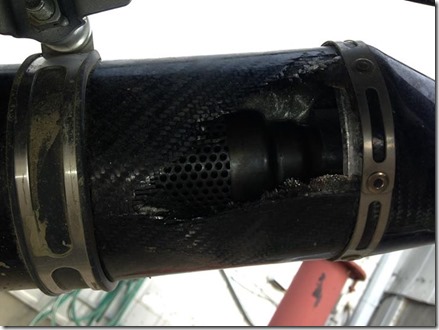 I’d prefer you didn’t ask “why,” but I follow a WR250X/R owners Facebook group for laughs. Facebook being what it is, the group is mostly the kind of characters who layer thousands of dollars in aftermarket silliness on their WR’s and whine about how their loud pipes are still not attracting the attention they deserve. Think South Park’s “rub, rub, rub, rub . . . “ in blue, white, or black with lots of emoticons. One of the kids on the list posted this picture of his near-new, grossly overpriced ($1,000) Graves “Works Exhaust System” which had burned through on a short ride from home to work. (Maybe that’s the “works” part of the exhaust?”)
I’d prefer you didn’t ask “why,” but I follow a WR250X/R owners Facebook group for laughs. Facebook being what it is, the group is mostly the kind of characters who layer thousands of dollars in aftermarket silliness on their WR’s and whine about how their loud pipes are still not attracting the attention they deserve. Think South Park’s “rub, rub, rub, rub . . . “ in blue, white, or black with lots of emoticons. One of the kids on the list posted this picture of his near-new, grossly overpriced ($1,000) Graves “Works Exhaust System” which had burned through on a short ride from home to work. (Maybe that’s the “works” part of the exhaust?”)
Manufacturers, especially the big four, have taken exhaust systems to some pretty incredible levels over the last two decades. Stainless steel headers and mufflers, electronically variable tuned systems, and at-or-below automotive noise levels are common. In other words, factory exhaust systems do exactly what they are supposed to do and deliver the broadest powerband practical for the engine (which has been tuned, mechanically and electronically, for the factory exhaust). When I was a kid (before the moon was born and when the sun was little-tiny), I did a lot of exhaust mods to my 2-stroke bikes. I cut and welded pipes, fashioned my own expansion chambers, tacked on “silencers” to get past state park spark arrester requirements, and did a lot of seat-of-the-pants “dyno tests.” After a few years of that foolishness, mostly I learned that my “engineering” was turning a moderately peaky motor into a narrow-band engine that worked in such a tiny powerband that the bike was practically unrideable. If I could keep the bike on the pipe, which was a pretty difficult task on most of the tracks I rode, it was definitely faster (also on the rare occasion that my “tuning” worked). If it fell off of the pipe, I was sometimes stranded on the track with a fouled plug or crawling along hoping to burn off the excess fuel before the bike stalled.
About the time I decided to spend less time on exhaust system experiments and more time on jetting, blueprinting the intake and exhaust ports, and suspension improvements, the kid I was tuning for started winning. Eventually, he (we) won the Nebraska state 125 expert class (A series) motocross series two years running on Suzuki RM’s. He and I both rode RMs in our respective classes (I was never more than a B Class rider) and we rode on bone stock exhaust systems as did the Yamaha riders who ended up owning the top two classes and four out of five top places in each class two years later.
 So-called dyno chart data like the stuff published by Graves for their fragile and over-priced pipe is information more aimed at the ego of the buyer than useful information. Dyno test results are notoriously unrepeatable and not created equal, “It all depends on the dyno and how it is reading and computing the power / load ratings. There are ‘inertia’ dyno's that give a particular number, and there are ‘load’ dyno's that give an entirely different number. Why do they do this you ask? If you took a typical DynoJet dyno (chassis dyno) and ran a car on it, it would give you a given number based on inertia and the spool-up speed of the drums. If you took that same car and put it on a Mustang Dyno or SuperFlow ‘load’ dyno, you would get a much lower number simply because they are measuring power under different circumstances (under a load).” An acquaintance who has owned a dyno since the 80’s and has tested and tuned hundreds, if not thousands, of bikes over his years as a master mechanic once told me that a 10-20% variance between tests is common and that any results demonstrating anything less than a 20% real improvement will mean nothing to the average expert class racer.
So-called dyno chart data like the stuff published by Graves for their fragile and over-priced pipe is information more aimed at the ego of the buyer than useful information. Dyno test results are notoriously unrepeatable and not created equal, “It all depends on the dyno and how it is reading and computing the power / load ratings. There are ‘inertia’ dyno's that give a particular number, and there are ‘load’ dyno's that give an entirely different number. Why do they do this you ask? If you took a typical DynoJet dyno (chassis dyno) and ran a car on it, it would give you a given number based on inertia and the spool-up speed of the drums. If you took that same car and put it on a Mustang Dyno or SuperFlow ‘load’ dyno, you would get a much lower number simply because they are measuring power under different circumstances (under a load).” An acquaintance who has owned a dyno since the 80’s and has tested and tuned hundreds, if not thousands, of bikes over his years as a master mechanic once told me that a 10-20% variance between tests is common and that any results demonstrating anything less than a 20% real improvement will mean nothing to the average expert class racer.
With that in mind, the maximum of 16% shown by the Graves’ data should pretty much be ignored as marketing babble. Unfortunately, to get real data you have to run multiple tests and average the results. “While we're at it, let me explain something about engine dynos. People say dynos don't lie. Well, they don't... but the people entering the acquisition data DO, and if they fudge the numbers here or there (barametric pressure, relative humidity, air density, air temperature, the amount of water being fed to the water brake, etc.) then the dyno can only compute what it is told to compute. So in reality, no... the dyno won't lie, but it will give bogus readings if the data isn't accurately fed into the machine.” Any information provided by anyone’s marketing department is more than likely bullshit. Keep that in mind before you toss your hard earned cash into the aftermarket toilet bowl.
Jun 8, 2015
#112 Slow Is Smooth, Smooth Is Fast
 |
As usual, I was harping on front brake use in a Basic MSF class when one of the students told me that a sniper's rule is "Slow is smooth, smooth is fast." Good rule. A military source for the context of this phrase describes how in combat situations "moving fast, or rushing it, is reckless and will likely get you killed. If you move slowly, carefully and deliberately however, you are really moving as fast as you can without needlessly increasing the risk on your life." My co-instructor said, "The slowest hands on the track belong to the fastest rider in the race." That all seems counterintuitive, doesn't it?
On a motorcycle, almost anything you do in a hurry will be wrong. I don't mean a little wrong, I mean life-threateningly wrong. We all know that the overwhelming majority of braking horsepower is in a motorcycle's front wheel; at least 70% in most situations. Experienced and inexperienced riders know that improper use of the front brake can put a rider on the ground nearly instantly. The difference between great breaking and a sudden dismount and road rash is, mostly, speed.
A few years back, I wrote about panic reactions and how they are always wrong and how they will kill you if you don't control them. It takes a lot of restraint to be slow and smooth when something sudden happens. Mostly, we're trying to control our panic reactions, those nasty fight-or-flight impulses that tell us exactly the wrong thing to do when emergency situations arise. Like money, panic reactions don't talk, they scream. When Bambi the hoofed rat jumps out in front of you, that's when all systems are blowing their "emergency, emergency" sirens and when "slow is smooth, smooth is fast" either happens or . . . you're on the road leaving bits of clothing and skin to mark your trail.
Practice is crucial to mastering a mechanical skill. In his book, This Is Your Brain on Music; the Science of A Human Obsession, Dr. Daniel Levitin said, ". . . ten thousand hours of practice is required to achieve the level of mastery associated with being a world-class expert — in anything. In study after study, of composers, basketball players, fiction writers, ice skaters, concert pianists, chess players, master criminals, and what have you, this number comes up again and again . . . it takes the brain this long to assimilate all that it needs to know to achieve true mastery." One way to get to ten thousand hours is to practice for three hours a day for ten years. That is a lot of braking practice. Hell, that's a lot more riding that most people can accomplish in a lifetime. But maybe we don't intend to become a "world class" motorcyclist: we just want to be safe and competent.
So, settle for something between the hours you've already put in and that magic 10,000. You can start by practicing a perfectly executed stop, balancing the front and rear brakes to accomplish a smooth and rapid deceleration, every time you stop your motorcycle. By practicing the technique as perfectly as we can manage every time we stop, we're making the beginning of an attempt at achieving our ten thousand hours. If I take the freeway to work, I have found that I apply my brakes about twenty times, each way. If I take surface streets, I brake about 60 times each way in normal traffic. That is a lot of opportunities for practice, five to seven times a week. Add the errands I run on the bike, occasional recreational travel, and the time spent on the range teaching motorcycling and I have a lot of available practice time. If I had this mindset when I started riding almost fifty years ago, I might be "expert" by now.
Studying the masters is a short-cut to mastery, too. The DVD/Blueray extras in movies like Faster give us all an opportunity to watch the hands of some of the greatest riders in history. I am always amazed at how deliberate Valentino Rossi's movements are; considering the insane speeds, powerful acceleration, deceleration and cornering forces, and close-quarter, high-traffic maneuvers involved. The only way to remain smooth under those conditions is to be absolutely habitual about the control use. The only way to develop those habits is to do them repeatedly, correctly, and intentionally.
We can argue about whether every day motorcycling is a sport, but there is no question that riding competently requires an uncommon skill set. Motorcycles bare little resemblance to cars. Any fool can balance a car and traffic indicates that lots of fools are doing just that with no knowledge of physics or mechanics. Motorcycles require exponentially more talent, experience, and attention than cars and trucks and that means we either have to develop those skills or risk becoming part of the increasingly depressing highway statistics. Working on using the brakes slowly, smoothly, and with power is a big part of the path to becoming an "expert" rider.
MMM September 2012
Jun 6, 2015
Bypassing the BRC: DIY
Now this is how we learned to ride in the Good Ol’ Days:
Yep, in a suit and everything. I always wore a suit and tie when I was a young man learning to ride my brother’s stolen Harley 250 Sprint. (He didn’t steal it, but I stole it from him.)
Any reasonable person would start the bike from the side. After all, you wouldn’t want to look like someone who has to be somewhere in a hurry. Lesson ten actually teaches you how to turn into a woman because everyone knows women have better balance than men. 
Five minutes! Not 4 1/2 hours of classroom and ten hours of intense boredom while two old guys in neon vests harp at you about using your brakes “properly” or looking where you’re going or using the handlebars to steer. Just jump on, twist the throttle and go! I feel like my last 13 years have been totally wasted. From now on, I’m throwing away the MSF program and handing this thing out to all of my students. It’s back to the future for me!
Damn. This only works on the “new lightweight Indian?”
Jun 4, 2015
PRODUCT REVIEW: Aerostich Triple Digit Rain Covers
All Rights Reserved © 2008 Thomas W. Day
 Aerostich Triple Digit Insulated Glove Covers $57.00 (Aerostich photo)
Aerostich Triple Digit Insulated Glove Covers $57.00 (Aerostich photo) If you pick your motorcycle gear by trying it on and looking in the mirror, you will probably pass on the Triple Digit Rain Covers. They look stupid. This product will turn your elegant, well trimmed five digit manipulators into three-fingered cartoon-character paws. This is a product that appeals only to those self-assured, style-ignorant types. Freaks who ride year-around, don't like being defeated by the weather, and don't care what they look like in the process.

Triple Digit Rain Covers saving me from the cold. $47.00 (T Day photo)
My only true complaint about this product is that I found it too late to save a good bit of my 2007 trip to Alaska. So, I need to go back and do some of that ride again. I was set from head to toe and chest to wrist for the trip, but my hand protection plan was a disaster. I carried two sets of "waterproof gloves" to the frozen north; a set of insulated First Gear motorcycle gloves and a pair of REI Goretex-lined skiing gloves. Both of these products failed to keep my hands dry and on several freezing days, my whole body comfort was destroyed because I could not keep my hands warm. It may be that 90% of your body heat is dedicated to keeping your brain and heart warm, but my experience demonstrated that the body doesn't want to let the hands go without a fight. The result of that fight is whole body discomfort.

Triple Digit Rain Covers protecting the back of my hand. (T Day photo)
Late in 2007, a friend and I were exploring the North Shore and stopped in Duluth for his first visit to the RiderWearhouse. I had been looking for a solution to my frozen hand problems and when I tried on the Triple Digit Rain Covers I found it. We both bought a pair and they have been a solution for a variety of cold and wet hand problems. The covers provide flawless rain protection, terrific wind and cold insulation, and the three finger design is absolutely functional, although a little comical. On my 2008 Nova Scotia trip, I was rained on for a dozen days and my hands were well protected. 2,,500 miles of North Dakota's 2009 spring rain and my hands stayed as dry as the rest of my 'stich-covered body. When the weather turned cold last fall, I didn't have to put away my summer gloves until after Thanksgiving. The covers pack small, too, so you can easily carry them in a jacket pocket for wet weather emergencies.
The Triple Digits are laminated ripstop nylon and the design includes an elastic drawcord and a hook and loop wrist cinch to keep the covers in place over your regular riding gloves. You'd think nylon would provide a slippery-when-wet grip on the bars, but the grip is fine. For my troll wrists, the cinch strap is too short to stay in place when I try to sneak my hands into the covers. Aerostich sent me a strip of the hook & loop material to extend the strap. If your hands don't look like hairy hams, you probably won't have this problem. The left thumb has a squeegee for cleaning your visor and you'll want to remember that when you wipe your nose. They come in dark blue and florescent orange and both have a Scotchlite reflective stripe to attract attention in traffic. They're available in M-XL sizes. Aerostich also makes an insulated version of the Glove Covers that adds even more protection from the cold, wet world we live in.
POSTSCRIPT: So, I’ve had my Triple Digits for seven years and they are still exactly as useful as they were in 2008. They extend (downwardly) the temperatures I can comfortably ride and even add a little to my visibility. I wouldn’t go any serious distance without these gloves in my tankbag.
Jun 3, 2015
More Evidence to be Ignored
UC Berkeley Study Shows Lane-Splitting Motorcyclists are Safer in Traffic
Among the U.C. Berkeley findings:
* Lane-splitting is safe if done in traffic moving at 50 mph or less, and if motorcyclists do not exceed the speed of other vehicles by more than 15 mph;
* 69 percent of lane-splitting motorcyclists were exceeding the traffic speed by 15 mph or less; speed differentials up to 15 mph were not associated with changes in the frequency of injury;
* Compared to riders who were not splitting lanes, lane-splitting motorcyclists were markedly less likely to suffer head injury (9 percent vs. 17 percent), torso injury (19 percent vs. 29 percent) or fatal injury (1.2 percent vs. 3 percent);
* Lane-splitting riders were significantly less likely to be rear-ended than non-lane-splitting riders (2.6 percent vs. 4.6 percent);
* Lane-splitting motorcyclists were more likely to be wearing a full-face helmet than other motorcyclists (81 percent vs. 67 percent);
* Compared to other motorcyclists, lane-splitting riders were more often riding on weekdays and during commuting hours, were using better helmets and were traveling at slower speeds;
* Lane-splitting riders were less likely to have been using alcohol.
The first one is probably the most important one of the list. The full-face helmet bit is probably important, too.
Clogging Up the Damn
From about every engineering and societal viewpoint, autonomous cars are the obvious future. That is, in fact, a fact. But it is possible that the US might be completely out of the progressive loop when this giant sociological change takes place. We’ve done it before. Often.
The US has a long history of being terrified by intelligence. We elect congress-critters, governors, and presidents whose sole credential is being (or appearing to be) a whole lot dumber than the average guy. Apparently, we mostly like ‘em stupid. Smart cars, then, have to scare the shit out of the ordinary mouth-breathing, NASCAR whooping, goofball. The scary news, if they were capable of reading it, is that computers are capable of out-smarting about 50% of us and have been since the Z80 days. In more recent times, computers are getting smarter every day while Americans are . . . downbreeding into puddles of terrified, conservative backsliders.
We did the coward/conservative thing in 1980 with Reagan’s promise to save us from having to “learn stuff.” When Reagan canned the United States Metric Board and ridiculed and ignored the requirements of the Metric Conversion Act, 15 U.S.C. 205d, most 'mericans cheered not having to adapt to the international measurement standard. Today, we’re the only industrialized nation in the world still concerned with the length of the King’s foot, the width of a man’s thumb (inch), or the rest of our disorderly, overly complicated SAE system. That bit of backwards thinking has been as expensive, on an annual basis, as our last two recreational wars. “Jos. V. Collins did some work on this question in 1915. He concluded in an article called, 'A metrical tragedy', that a 'Total annual loss of $315 000 000' could be attributed per year to non-metrication in the USA at that time.” In today’s money, that would amount to about $6.5B/year. We could pay for all sorts of idiot wars and invasions with that kind of money or we could make stuff we and the rest of the world want to buy. Currently we don’t make much that anyone else wants and what we do make is being replaced by foreign (non-USA) sources.
With that history in mind, it is totally possible to imagine ‘mericans stubbornly screeching “You’ll have to take the steering wheel from my cold, dead hands” while the rest of the world efficiently converts personal vehicles to a municipally-owned autonomous transportation system. Because we’ll be a backwards market, our auto manufacturers will stick with old-world transportation and manufacturing models and products and they will slowly become as obsolete as their products; dying off one-by-one like their US competition did in the 1950’s. Eventually, only 3rd world manufacturers will service the US market’s demand for 20th Century transportation technology and we’ll join them in their misery. Most of our 1% will move to where the lifestyles are more comfortable (and modern), since none of those folks have any more loyalty to the United States than do our corporations.
I suppose some people will look forward to an America that resembles the Mad Max vision of cobbled-together junk-mobiles. Most of the Southeast and the Rust Belt won’t notice a change at all.



